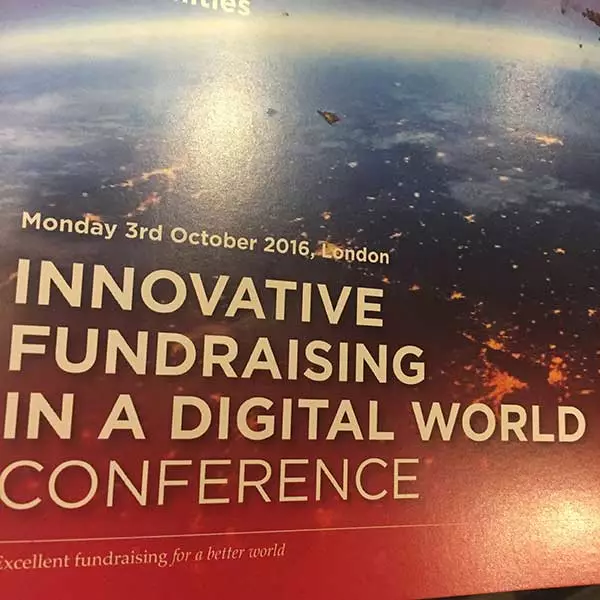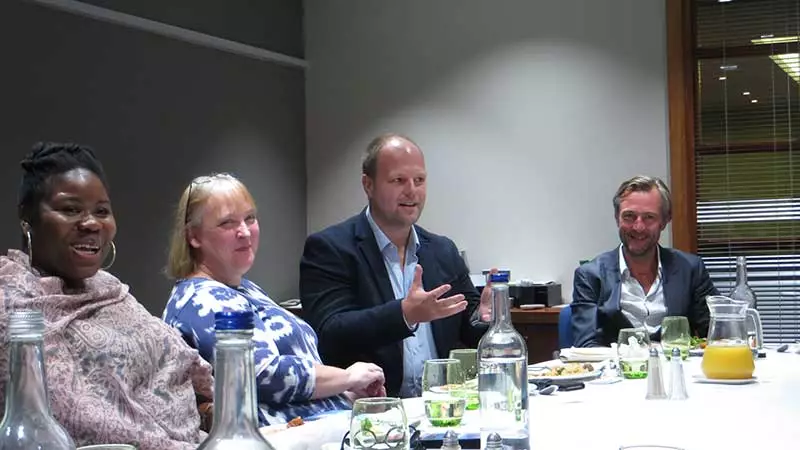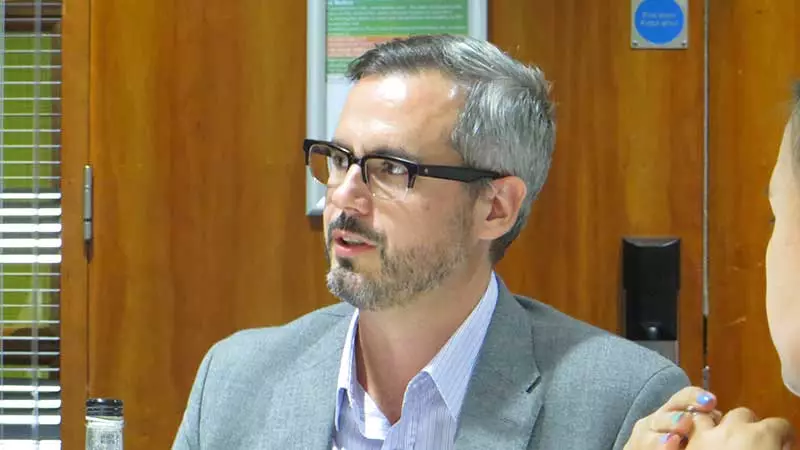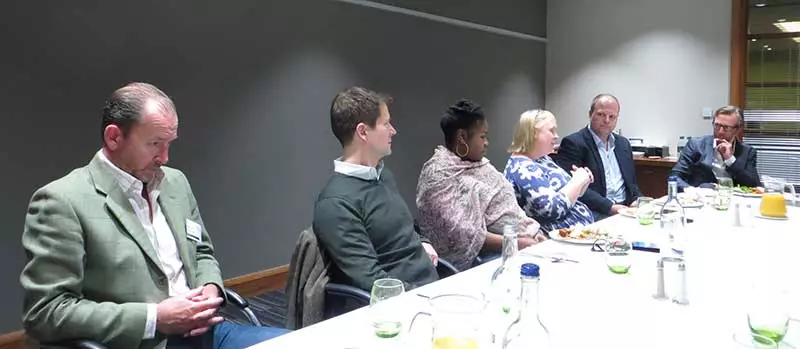Fundraisers debate the potential for ‘lifestyle giving’
A roundtable of digital fundraisers and digital giving platform providers met last month to discuss the potential for ‘lifestyle giving’.
Chaired by Adam Bryan, the discussion took place during the Institute of Fundraising’s conference on innovation through digital fundraising. It was the idea of the team at Savoo.co.uk, the platform that raises funds for charities through voucher codes and online searches. Its CEO Simon Bird explained his ideas around lifestyle giving and why he thought they could help significantly boost charitable giving in the UK. He suggested it might hold the key to persuading Generation Z to support charities.

The roundtable took place during the lunchtime break at IoF’s digital fundraising conference.
‘Passive giving’?
Bryan introduced the notion of lifestyle giving, describing it in the context of enabling some donors to grow into giving, tapping into their existing shopping and payment habits. He used an earlier term for it, ‘passive giving’.
While the notion met with interest and some support, the latter term was not welcomed.
“I don’t like the term ‘passive giving” started Lisa Clavering, Digital Fundraising Manager at Anthony Nolan.
“’Passive’ implies a disconnect and a lack of engagement with the cause, which goes against all of the work we do in fundraising to inspire and motivate people to give”, she added.
“Would you want to bring on someone who is a ‘passive donor’ or ‘passive fundraiser’?” asked another fundraiser. “How would you know what their lifetime value is, if that one-off gift doesn’t link to a clear interest in the charity? Where’s the link?”
The participants then attempted to come up with a definition for ‘lifestyle giving’. They agreed that they knew it when they saw it, and there were a several examples of providers at the roundtable who would fit that criteria.
Lifestyle giving would probably incorporate mostly digital fundraising platforms that added a donation to a purchase, passed on a share of advertising generated from a search or web page view, rounded up a payment to the nearest pound to make a micro donation, and that made giving small amounts frictionless and almost second nature.
But should it also be extended to other forms of regular giving, such as payroll giving, that once set up tended to deliver long-term income? The participants decided that that should not be the case.
Would raffles and competitions be included? Simon Rydings, CEO of Capen, commented:
“Prize-led fundraising is active. Some of our charity clients treat it as a passive giving source, usually because they’ve got a commercial partner who is active in it”.
“The prize can get people through the door, but it’s the mission that closes the deal. We find that promoting the mission increases the average basket value by 50%”.Advertisement
Another participant suggested using the phrase “in-the-moment giving”.
Fragmented opportunity
It was noted that lifestyle giving is well established in the sector, given that charity credit cards have been raising funds at no cost to the donor for 30 years or so.
Mark Burnett, fundraising consultant for Give as you Live, commented:
“We need to raise more money. Passive giving isn’t new at Give As You Live. We’ve raised £8m for charities since we launched.
“It’s very much a partnership. Sometimes it works well, sometimes not. We need the public to know that they can raise money for free”.
Michael Dochery, Director of Digital and Supporter Experience at Cancer Research UK, said:
“There’s a massive opportunity in this space, but it’s a fragmented opportunity.
“There are examples in the market where this lifestyle giving operates, but we as an industry need to get together and grow this market”.
It was also noted that there was potential for growing this kind of activity through new methods of payment, such as contactless card payment and Apple/Android Pay. Combining these with the option of adding in a microdonation could appeal to an even wider audience of people including those who do not currently give to charity.
But how much data would be available from such supporters, and would they *want* to share it?
Dochery mused:
“Do we want to generate income, make it as easy as possible, and make a trade-off with data? Or would we prefer to make better connections, in which case it might make it harder for supporters to give anonymously?”
Fit within fundraising?
Cheri Percy, Digital Channels Manager at Breast Cancer Care, pondered on where lifestyle giving might fit within a fundraising strategy:
“Is it a standalone thing or an add-on? Our hub-and-spoke programme is enabling our digital team to be more strategic. This isn’t something we’d choose to do on our own, but are there opportunities to add passive giving on to other projects?”
Neilza Polidore from Greenpeace added:
“I don’t know whether we have the resources to promote it. And what about the supporter journey?”
She wondered how charities would communicate effectively with lifestyle giving supporters who did no more than make small donations via these methods. And what if most of them chose to remain anonymous?
There was a further issue for her organisation. “For Greenpeace” she said, “it’s a contentious issue – dealing with companies and products. But we could consider it if focused on ethical products.”
Tracy Holmstrand, Digital Fundraising Manager at The Children’s Society, commented:
“I would see this as an addition to our fundraising, but where does it sit in the organisational structure? Where do donors go after this?”
Adam Bryan noted that one difficulty faced by many charities is the need to focus on key fundraising messages, rather than promote too many opportunities. He said:
“I spoke to a senior fundraising director who said he was limited in how many times he could communicate with supporters. He had to choose what he promoted and when”.
Yvonne Cavalier, Digital Fundraising Strategy Manager at RSPCA, recognised that issue. She said:
“The idea is good. We just need to integrate it into everyday life. It needs to include a feel-good element too.
“The proposition would then become easier for us to integrate it with audience interactions. At the moment it’s a very difficult proposition to sell because of the low income it has yielded”.
Audience need?
Approaching lifestyle giving from the individual’s point of view, the question was posed:
“It’s not about raising money. What’s the audience need to be met through lifestyle giving?”
The technology might make it easy, but plenty of digital fundraising had fallen flat on the assumption that a frictionless tool would itself invite donations.
CRUK’s Michael Dochery noted:
“The problem is it’s asking for a behavioural change for not a big reward. And it will go against our ingrained behaviour of using Google.
“We should be using cash back sites, but we’re not. If we did we would all be saving money”.
“The answer is easy, integrated giving. One of our successful partnerships is with Scottish Power. The donation is built in with the tariff. Something that is integrated into an existing behaviour will be easier for us to promote”.
What would successful lifestyle giving look like?
RSPCA’s Cavalier suggested the hallmarks of how lifestyle giving might work and prove popular. She said:
“A successful scheme needs to be small and generic, like putting coins in a tin at the store. It needs to be a tiny, regular amount that they don’t think about. But it’s there enough so that you can talk to them about it when you’re talking about other fundraising opportunities. It needs to be part of the supporter journey, and not one that sits only in the corporate fundraising team”.
CRUK’s Dochery concurred, saying:
“The platforms need to be easier for the public to adopt. It needs to be simple and applied across all my devices. But I think there’s real opportunity to do deals with corporates to integrate it. If a platform had a suite of these partnerships in the platform that allowed people to had choice e.g. over cause, it might make it more compelling. The value would be far greater than it currently is”.
The corporate opportunity cropped up several times during the one-hour discussion, as a possible route to secure new supporters (or participants?) in lifestyle giving.
Simon Bird (Savoo) said:
“It’s increasingly about the right cause to fit the right corporate to fit the right technology”.
There was also agreement about the need for simplicity.
Give As You Live’s Mark Burnett said:
“At GAYL our data confirms we need to make the process as short as possible, so we’re working on some developments in that way. The future of lifestyle giving will be automated. (So you engage once, and then it just happens!). That will make it more acceptable.
“Also, our research shows that most people who give via GAYL *also* give financial donations to charities. So at the moment, we don’t find a group of people who don’t give to charity traditionally but do give via GAYL.” So at the moment lifestyle giving is complementing traditional giving, people are giving both ways…”
Tracy Holmstrand (The Children’s Society) suggested one way that lifestyle giving platforms could help address a common problem for charities, saying:
“The biggest roadblock is charities with systems that are not nimble at all. So if you can offer a bit of code, an API, a small setup feee, that might help us use what we have to fit into what you would bring on board”.
Conclusions
At the end of the session, the participants summed up their thoughts on this type of fundraising.
Lisa Clavering (Anthony Nolan) said:
“I’ll adopt watchful waiting. It’s not a problem that we can solve right now. It feels like if anyone is going to crack this it is one of the charities with brand recognition”.
Neilza Polidore at Greenpeace took a similar stance, saying she wasn’t sure. However:
“For us, it’s worth trying. There’s nothing wrong with people giving in that way. It would be better to have a relationship with these people, than not to have any.
“But we would need to see which charities are making it work”.
Yvonne Cavalier (RSPCA) said:
“We should be working with corporates on this. We should expect the corporates to do more to help promote us and our messages to their larger audiences.
“But we should look at it from the audience perspective, not just the corporate perspective. Just because a corporate has a relationship with one charity, it doesn’t meant the audience wants to support that charity.”
Cheri Percy (Breast Cancer Care) weighed up the risk and opportunities, saying:
“If there was an add-on that was adaptable that would be good for us. We can be agile and test but need to be sure we don’t have something that has damaging ramifications e.g. Mother’s Day. We need to be sensitive about that”.
Savoo’s Simon Bird closed the discussion by proposing that setting up a working group at the IoF where they would plan a range of activities starting with a green paper to continue the discussion, to run events, and to set up a website, not just for Savoo but all lifestyle giving companies. This website would be ready later this year or in early 2017.
The website will feature information on how charities can use lifestyle giving and how consumers can make the most of the opportunity.






